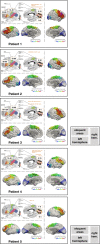Clinical correlates of mathematical modeling of cortical spreading depression: Single-cases study
- PMID: 31503424
- PMCID: PMC6790336
- DOI: 10.1002/brb3.1387
Clinical correlates of mathematical modeling of cortical spreading depression: Single-cases study
Abstract
Introduction: Considerable connections between migraine with aura and cortical spreading depression (CSD), a depolarization wave originating in the visual cortex and traveling toward the frontal lobe, lead to the hypothesis that CSD is underlying migraine aura. The highly individual and complex characteristics of the brain cortex suggest that the geometry might impact the propagation of cortical spreading depression.
Methods: In a single-case study, we simulated the CSD propagation for five migraine with aura patients, matching their symptoms during a migraine attack to the CSD wavefront propagation. This CSD wavefront was simulated on a patient-specific triangulated cortical mesh obtained from individual MRI imaging and personalized diffusivity tensors derived locally from diffusion tensor imaging data.
Results: The CSD wave propagation was simulated on both hemispheres, despite in all but one patient the symptoms were attributable to one hemisphere. The CSD wave diffused with a large wavefront toward somatosensory and prefrontal regions, devoted to pain processing.
Discussion: This case-control study suggests that the cortical geometry may contribute to the modality of CSD evolution and partly to clinical expression of aura symptoms. The simulated CSD is a large and diffuse phenomenon, possibly capable to activate trigeminal nociceptors and to involve cortical areas devoted to pain processing.
Keywords: cortical spreading depression; diffusion tensor imaging; finite element method; magnet resonance imaging; migraine with aura; patient-specific mathematical model.
© 2019 The Authors. Brain and Behavior published by Wiley Periodicals, Inc.
Conflict of interest statement
The authors declare no competing interest.
Figures


Similar articles
-
Patient-specific computational modeling of cortical spreading depression via diffusion tensor imaging.Int J Numer Method Biomed Eng. 2017 Nov;33(11). doi: 10.1002/cnm.2874. Epub 2017 Apr 11. Int J Numer Method Biomed Eng. 2017. PMID: 28226410
-
Activation of meningeal nociceptors by cortical spreading depression: implications for migraine with aura.J Neurosci. 2010 Jun 30;30(26):8807-14. doi: 10.1523/JNEUROSCI.0511-10.2010. J Neurosci. 2010. PMID: 20592202 Free PMC article.
-
[Cortical spreading depression (CSD): a neurophysiological correlate of migraine aura].Schmerz. 2008 Oct;22(5):544-6, 548-50. doi: 10.1007/s00482-008-0653-9. Schmerz. 2008. PMID: 18483750 Review. German.
-
Somatosensory migraine auras evoked by bihemispheric cortical spreading depression events in human parietal cortex.J Cereb Blood Flow Metab. 2025 Mar;45(3):558-567. doi: 10.1177/0271678X241290606. Epub 2024 Oct 13. J Cereb Blood Flow Metab. 2025. PMID: 39397399 Free PMC article.
-
Cortical spreading depression and migraine.Nat Rev Neurol. 2013 Nov;9(11):637-44. doi: 10.1038/nrneurol.2013.192. Epub 2013 Sep 17. Nat Rev Neurol. 2013. PMID: 24042483 Review.
Cited by
-
Mapping Brain Structure Variability in Chronic Pain: The Role of Widespreadness and Pain Type and Its Mediating Relationship With Suicide Attempt.Biol Psychiatry. 2024 Mar 1;95(5):473-481. doi: 10.1016/j.biopsych.2023.07.016. Epub 2023 Aug 4. Biol Psychiatry. 2024. PMID: 37543299 Free PMC article.
-
Revisiting Migraine Pathophysiology: from Neurons To Immune Cells Through Lens of Immune Regulatory Pathways.J Neuroimmune Pharmacol. 2025 Apr 2;20(1):30. doi: 10.1007/s11481-025-10197-3. J Neuroimmune Pharmacol. 2025. PMID: 40172704 Review.
-
Migraine Visual Aura and Cortical Spreading Depression-Linking Mathematical Models to Empirical Evidence.Vision (Basel). 2021 Jun 10;5(2):30. doi: 10.3390/vision5020030. Vision (Basel). 2021. PMID: 34200625 Free PMC article.
References
Publication types
MeSH terms
LinkOut - more resources
Full Text Sources
Miscellaneous

